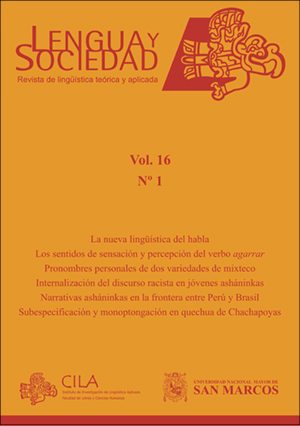Underspecification and monophthongization in the first and second possessive markers in Chachapoyas Quechua
DOI:
https://doi.org/10.15381/lengsoc.v16i1.22386Keywords:
Monophthongization (Fusion), Underspecification, Lexical Phonology, Possessive Person Markers, Chachapoyas QuechuaAbstract
This paper discusses on the emergence of long and short monophthongized vowels in a number of suffixes of the Quechua variety spoken in Chachapoyas. In particular, vowel monophthongization occurs within the possessive suffixes that mark first and second person in this Quechua variety. Previous studies have explained that alternations between [i]/[i:] and [e]/[e:] are the result of variations in the quality of the initial segment /-y/ that appears in both first and second person possessive suffixes. Similarly, previous research has described the alternation between short and long vowel segments (i.e. [i]/[i:] and [e]/[e:]) as the outcome of stress variation. However, recent acoustic evidence suggests that the initial segment of both possessive suffixes is not /-y/ but a subespecified coronal segment. Moreover, this evidence allows to explain the alternation between short and long vowels as caused by the lexical phonology of Chachapoyas Quechua rather than as a result of stress variation. After discussing these new findings, this paper provides some insights about the linguistic change of the first person possessive suffix in other Quechua varieties.
References
Barbieri, Ch. y otros. (2017). Enclaves of genetic diversity resisted Inca impacts on population history. Scientific Reports 7, Article number: 17411. doi: 10.1038/s41598-017-17728-w
Cerrón-Palomino, R. (2003). Lingüística quechua [2.a Ed.]. Cusco: Centro de Estudios Rurales Andinos "Bartolomé de Las Casas".
Chaparro, C. (1958). Fonología y lexicón del quechua de Chachapoyas. Lima: Editorial Sagsa.
Clements, G. y Hume, E. (1995). The Internal Organization of Speech Sounds. En Odden, D., y Goldsmith, J., The Handbook of Phonological Theory (pp. 245- 306). Cambridge/Oxford: Blackwell.
Cole, J. (1995). The Internal Organization of Speech Sounds. En Odden, D., y Goldsmith, J., The Handbook of Phonological Theory (pp. 70-113). Cambridge/Oxford: Blackwell.
Escribens, A. y Proulx, P. (1970). Gramática del quechua de Huaylas. Lima: UNMSM.
Heggarty, P. (2005). Enigmas en el origen de las lenguas andinas: aplicando nuevas técnicas a las incógnitas por resolver. Revista Andina, 40, 9–57.
Julca Guerrero, F. (2009). Quechua ancashino. Una mirada actual. Lima: CARE Perú/ Fondo Editorial del Pedagógico San Marcos.
Parker, G. (1976). Gramática quechua Áncash-Huailas. Lima: IEP/MINEDU.
Quesada-Castillo, F. (1988). Phonological Processes in Quechua and Their Implications for Phonological Theory. Tesis doctoral, State University of New York at Buffalo.
Schane, S. (1995). Diphthongization in Particle Phonology. En The Handbook of Phonological Theory. En Odden, D., y Goldsmith, J., The Handbook of Phonological Theory (pp. 586-608). Cambridge/Oxford: Blackwell.
Solís, G. (1996). Los orígenes de la cantidad vocálica en quechua. Documento de Trabajo, 56. Lima: CILA-UNMSM.
Steriade, D. (1995). Underspecification and Markedness. En The Handbook of Phonological Theory. En Odden, D., y Goldsmith, J., The Handbook of Phonological Theory (pp. 112-174). Cambridge/Oxford: Blackwell.
Taylor, G. (2006). Diccionario quechua Chachapoyas Lamas. Lima: IFEA/IEP. (2000). Estudios lingüísticos sobre Chachapoyas. Lima: UNMSM/IFEA. (1994). Estudios de dialectología quechua (Chachapoyas, Ferreñafe, Yauyos). Lima: UNE.
Torero, A. (2002). Idiomas de los Andes. Lingüística e Historia. Lima: IFEA/Editorial Horizonte.
Unesco (2003). Vitalidad y peligro de desaparición de las lenguas. Documento adoptado por la Reunión Internacional de Expertos sobre el programa de la UNESCO “Salvaguardia de las Lenguas en Peligro”. París.
Valqui, J. y Ziemendorff, M. (2016). Vestigios de una lengua originaria en el territorio de la cultura chachapoya. Letras, 87 (125), 5-32.
Weber, D. (1975). Apuntes sobre el quechua de Lamud. SIL.
Downloads
Published
Issue
Section
License
Copyright (c) 2017 Jairo Valqui, Gustavo Solís, Carlos Faucet, Franklin Espinoza, Liz Velásquez

This work is licensed under a Creative Commons Attribution 4.0 International License.
AUTHORS RETAIN THEIR RIGHTS
a. Authors retain their trade mark rights and patent, and also on any process or procedure described in the article.
b. Authors can submit to the journal Lengua y Sociedad, papers disseminated as pre-print in repositories. This should be made known in the cover letter.
c. Authors retain their right to share, copy, distribute, perform and publicly communicate their article (eg, to place their article in an institutional repository or publish it in a book), with an acknowledgment of its initial publication in the journal Lengua y Sociedad.
d. Authors retain theirs right to make a subsequent publication of their work, to use the article or any part thereof (eg a compilation of his papers, lecture notes, thesis, or a book), always indicating its initial publication in the journal Lengua y Sociedad (the originator of the work, journal, volume, number and date).






